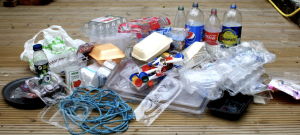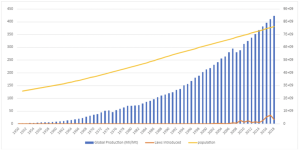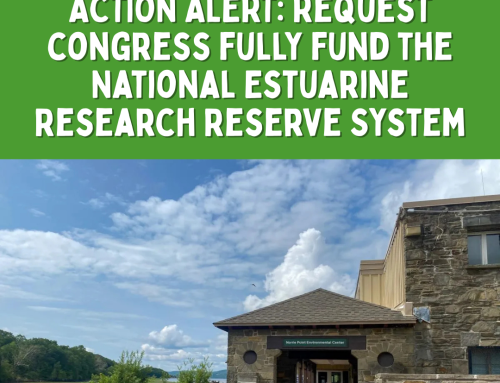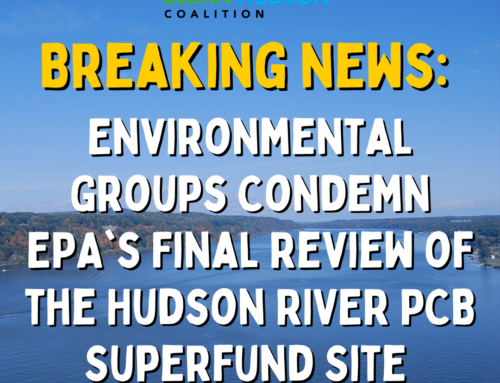A Brief Introduction to Single-Use Plastics and How You Can Help Reduce Their Use and Impact
As the global population has grown, the production and use of single-use plastics have accelerated tremendously. A modern convenience, single-use plastics have become ubiquitous – with one million single-use plastic items purchased every minute, and up to five trillion plastic bags are used worldwide every year.
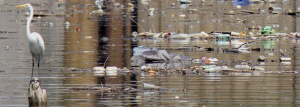
An egret alights amid floating trash contained by a boom in the Bronx River. (Photos: Leah Rae / Riverkeeper)
The Natural Resources Defense Council defines single-use plastics as products made primarily from fossil fuel–based chemicals (petrochemicals) and are meant to be disposed of right after use—often, in mere minutes. Single-use plastics are most commonly used for packaging and service, such as bottles, wrappers, straws, and bags.
Despite the ease and convenience of these products, their use has significant ecological impacts and perpetuates extraction and use of climate change, with 150 million tons of plastic produced for single-use items alone.
Over the last decade, movements around the world have begun to advocate for reduced creation and use of single-use items – including New York State’s Bag Waste Reduction Act which went into effect on March 1, 2020 – which begets the question in what ways does continued production of single-use plastic harm society and the environment?
Harm To Ecosystems and Wildlife
Single-use plastics – particularly plastic bags and food packaging are often discarded after a few short minutes of use, and end up on streets and sidewalks where they can be carried by rain into nearby waterways. Once in marine ecosystems, fish, seabirds, sea turtles, and marine mammals can become entangled in or ingest plastic debris. When animals consume plastics, they are unable to digest them, and can block airways, or fill their stomachs, resulting in starvation.
A peer-reviewed article by Science of The Total Environment describes numerous cases of injuries and death to marine and non-marine species caused by the Ingestion of plastics by species both on land and in water that have been reported in lake, riverine, forest, and ocean ecosystems, and have been connected to injury and death of wildlife. rivers, lakes, seas, and forests.
Moreover, plastic pollution is a global problem. Every year 19-23 million tonnes of plastic waste leaks into aquatic ecosystems, polluting lakes, rivers, and seas. Single-use plastics can alter habitats and natural processes, reducing ecosystems’ ability to adapt to climate change, and directly affecting millions of people’s livelihoods, food, production capabilities, and social well-being.
Impacts On Human Health
Microplastics are in salt, beer, fresh fruit and vegetables, and drinking water. Airborne particles can circle the globe in a matter of days and fall from the sky like rain. Seagoing expeditions to count microplastics in the ocean produce incomprehensible numbers, which have multiplied over time as more tonnage of plastic waste enters the oceans every year and disintegrates.
In recent decades, several human health issues have been reported to be associated with increased rates of plastics in oceans. Microplastics can affect various systems in the human body, including the digestive, respiratory, endocrine, reproductive, and immune systems. First, the digestive systems are affected when microplastics are ingested, and physical irritation to the gastrointestinal tract may eventually cause inflammation, resulting in various gastrointestinal symptoms.
How Much Single-Use Plastics Are Being Created?
To give a glimpse into plastics production, data from Statista show that the world produces 300 million tons of plastic annually, with half of that being single-use items. In 2021, the world produced 137 million tonnes of single-use plastics from fossil fuels, and researchers predict that this will increase to 17 million tonnes by 2027.
Global Plastic Production 1950-2022
The chart illustrates the global production of single-use plastics drastically increased from 1950 to 2018. As the world population increases, the production of plastic also increases and the law that regulated the production of single-use plastic was only introduced around 2007. Between 1950-2017, an estimated 9.2 billion tons of plastic have been manufactured. Of this, a little more than one quarter is still in use, while only 600 million tons have been recycled. Each year, the global plastic burden increases by about 300 million tons of plastic waste. By 2050, global production of single-use plastic is predicted to be higher than at any point in history. Annual production volumes are expected to continue rising in the following decades, rising to approximately 590 million metric tons by 2050 unless meaningful and timely action is taken.
Action Is Needed At All Levels – How You Can Help
There are small habits we can develop and practice that help to keep our environment clean and sustainable. Here is how you can reduce the number of single-use plastic:
-
Reduce your use of disposable shopping bags by using reusable bags.. Refuse a bag for easy-to-carry purchases.
-
Avoid single-use cutlery and straws. Bring your own reusable utensils and reusable straw for situations where the only option is single-use
-
Opt for glass or stainless steel reusable containers. The use and purchase of reusable plastic containers still support the continued production of single-use plastic.Not only will the planet appreciate it, but so will your health because plastics can release harmful substances.
-
Buy in bulk and avoid packaging when possible Disposable containers are inundating supermarkets (polystyrene trays, PET bottles, tetra paks, plastic containers, plastic wraps etc.). Opt to buy in bulk and refill reusable glass containers. Buy fruit and vegetables that aren’t wrapped in plastic.
-
Conduct a single-use plastics inventory Evaluate what single-use plastic products you use and how often. Consider what changes you can make to lessen your use. Carrying a reusable water bottle is an easy alternative to buying plastic water bottles.
-
Support the Packaging Reduction & Recycling Infrastructure Act (S4246-a/A5322-a). The bill prohibits the use of certain toxic chemicals, including PFAS, vinyl chloride, lead, mercury, formaldehyde, bisphenols, and toluene in common food packaging, including baby food. These chemicals are carcinogenic, endocrine-disrupting, or otherwise harmful to human health. Learn more from our partners at Beyond Plastics.
Always and forever remember: “Just because plastic is disposable doesn’t mean it just goes away. After all, where is away? There is no away.” – Jeb Berrie
Written by Paulo Araujo, a Bennington College Environmental Action Fellow at the Hudson River Sloop Clearwater in winter 2024. Paulo is a rising junior student at Bennington College, he studies Economics and Sustainability. Before attending Bennington College, Paulo graduated from a two-year diploma program at the African Leadership Academy – ALA in Johannesburg. Paulo focused on economics and business studies at ALA, laying the foundation for his current academic pursuits. He is academically interested in understanding how economic sustainability can alleviate global challenges such as poverty, inequality, and global warming. Paulo was born and raised in Beira, Mozambique.

